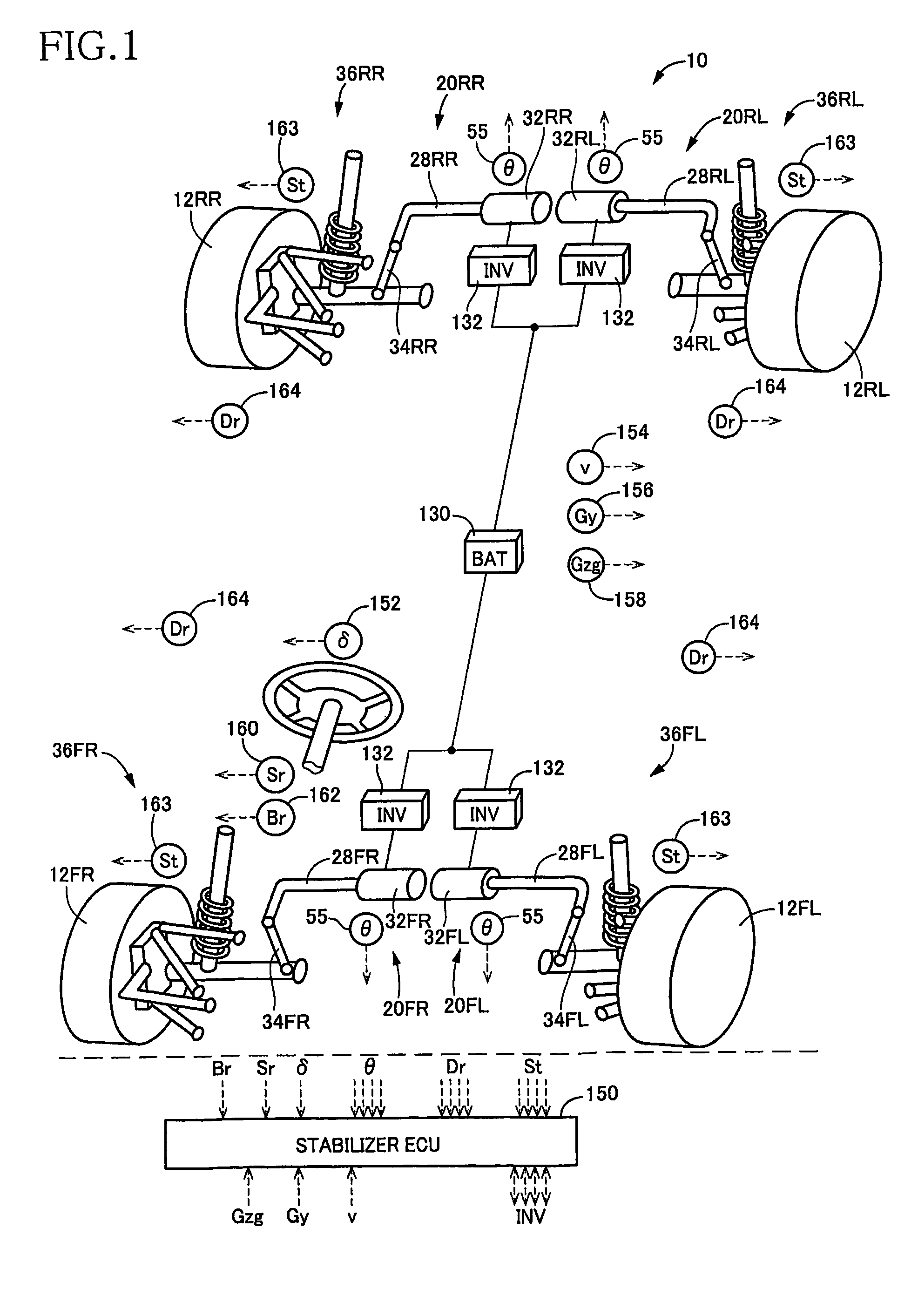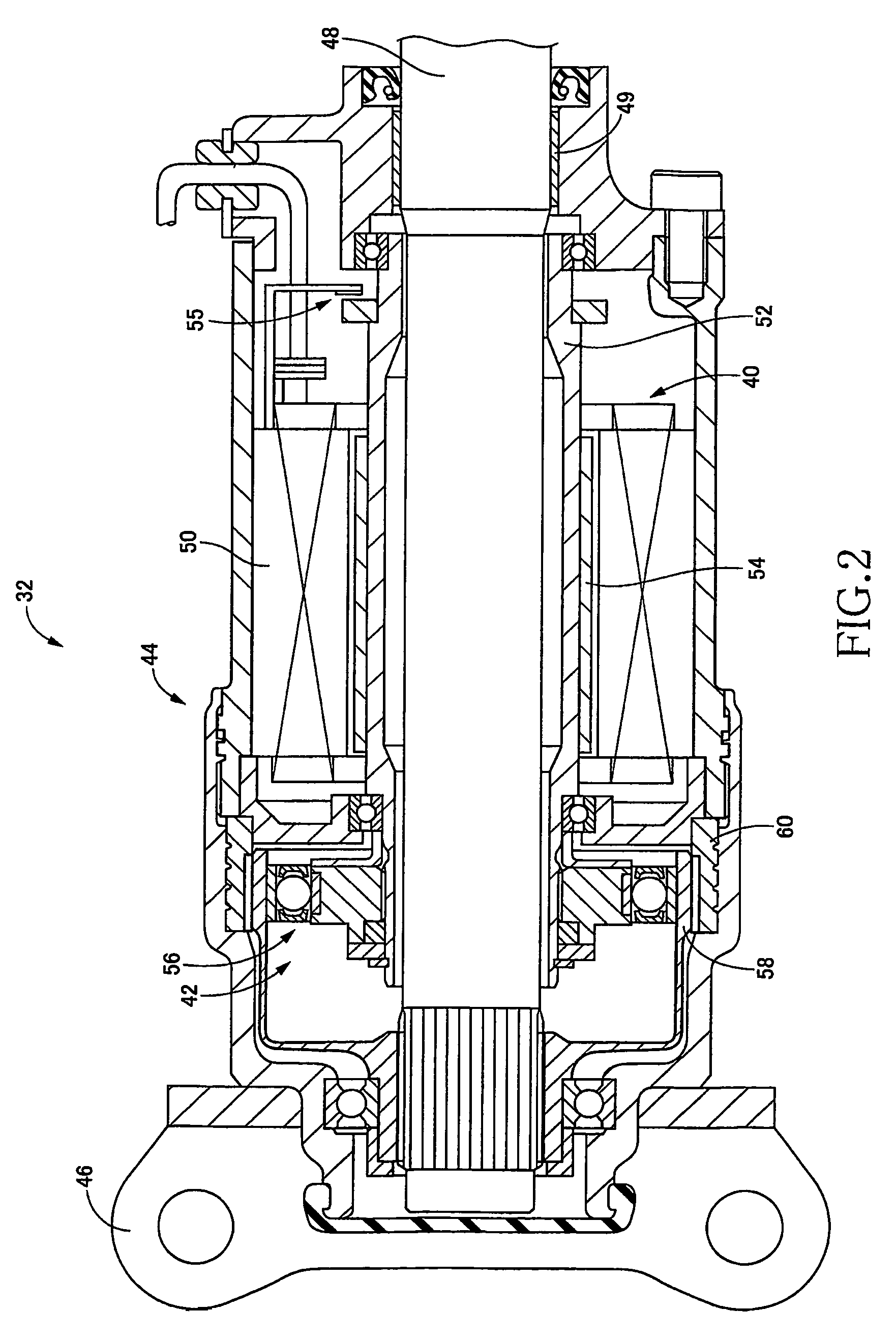Vehicle stabilizer system
a technology of vehicle stabilizer and stabilizer plate, which is applied in the direction of vehicle springs, interconnection systems, resilient suspensions, etc., can solve the problem of not being able to obtain the desired cornering characteristic of the vehicle, and achieve the effect of maximizing efficiency, facilitating understanding, and high serviceability
- Summary
- Abstract
- Description
- Claims
- Application Information
AI Technical Summary
Benefits of technology
Problems solved by technology
Method used
Image
Examples
first embodiment
(A) First Embodiment
[Construction and Function of Stabilizer System]
[0059]FIG. 1 schematically shows a vehicle stabilizer system 10 constructed according to a first embodiment of the invention. The stabilizer system 10 includes four stabilizer devices 20 provided for respective four wheels (i.e., front right, front left, rear right and rear left wheels) 12. Each of the stabilizer devices 20 includes a stabilizer bar 28, an actuator 32 operable to rotate the stabilizer bar 28, and a link rod 34. In a vehicle equipped with the present stabilizer system 10, four suspension devices 36 are provided for the respective four wheels, independently of each other. The stabilizer bar 28 is connected at one of its opposite end portions to the corresponding suspension device 36 via the link rod 34, and is connected at the other end portions to the corresponding actuator 32. As is apparent from FIG. 1, the suspension device 36, stabilizer device 20 and stabilizer bar 28 are provided for each of th...
second embodiment
(B) Second Embodiment
[0103]Referring next to FIGS. 15-18, there will be described a vehicle stabilizer system 180 constructed according to a second embodiment of the invention. In this vehicle stabilizer system 180, the pitch reduction control and the body-height adjustment control are executed although the roll reduction control is not executed. In the following description, the same reference signs as used in the first embodiment will be used to identify the functionally corresponding elements, and redundant description of these elements is not provided.
[0104]The stabilizer system 180 includes a pair of stabilizer devices 182, one of which is provided for the front wheels 12FR, 12FL and the other of which is provided for the rear wheels 12RR, 12RL. Each of the stabilizer devices 182 includes a stabilizer bar 184, an actuator 186 operable to rotate the stabilizer bar 184, and a pair of link rods 188. The stabilizer bar 184 is connected at its axially opposite end portions to the re...
third embodiment
(C) Third Embodiment
[0112]Referring next to FIGS. 19-23, there will be described a vehicle stabilizer system 220 constructed according to a third embodiment of the invention. In this vehicle stabilizer system 220, the roll reduction control is executed although the pitch reduction control and the body-height adjustment control are not executed. In the following description, the same reference signs as used in the first embodiment will be used to identify the functionally corresponding elements, and redundant description of these elements is not provided.
[0113]The stabilizer system 220 includes a pair of stabilizer devices 222, one of which is provided for the front wheels 12FR, 12FL and the other of which is provided for the rear wheels 12RR, 12RL. Each of the stabilizer devices 222 includes a pair of stabilizer bars 224, an actuator 226 operable to rotate the stabilizer bars 224 relative to each other, and a pair of link rod 228. Each of the stabilizer bars 224 is connected at one ...
PUM
 Login to View More
Login to View More Abstract
Description
Claims
Application Information
 Login to View More
Login to View More - R&D
- Intellectual Property
- Life Sciences
- Materials
- Tech Scout
- Unparalleled Data Quality
- Higher Quality Content
- 60% Fewer Hallucinations
Browse by: Latest US Patents, China's latest patents, Technical Efficacy Thesaurus, Application Domain, Technology Topic, Popular Technical Reports.
© 2025 PatSnap. All rights reserved.Legal|Privacy policy|Modern Slavery Act Transparency Statement|Sitemap|About US| Contact US: help@patsnap.com



